Best Pasta Sauces
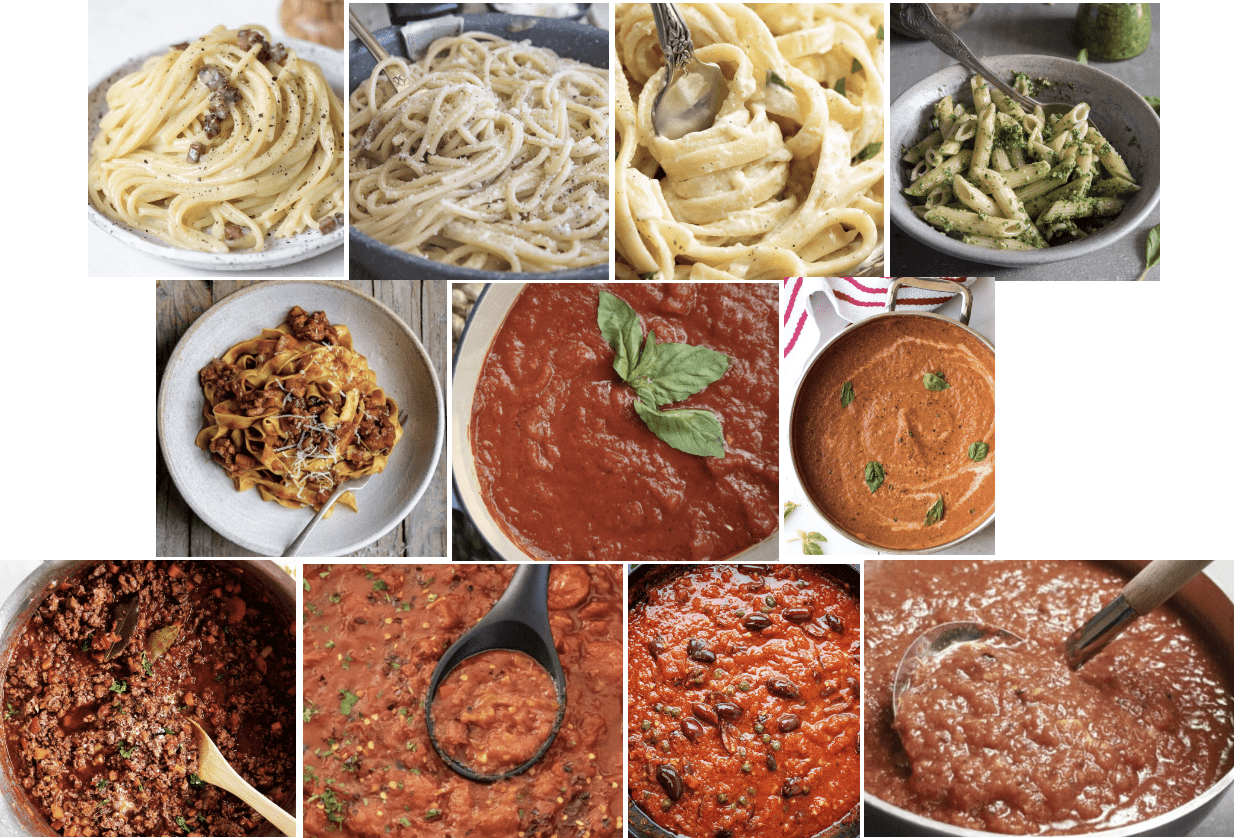
Best Pasta Sauces – Tomato sauce is first referenced in the Italian cookbook Lo Scalco alla Moderna (The Modern Steward), written by Italian chef Antonio Latini in 1692.
Meanwhile, a recipe for pasta with tomato sauce appears in the 1790 cookbook, L’Apicio Moderno, by chef Francesco Leonardi.
The use of tomato sauce with pasta was first recorded in 1790 in the L’Apicio Moderno cookbook by Francesco Leonardi.
However, tomatoes didn’t really take off until the mid-19th century, because they were originally thought to be poisonous.
What did Italians put on pasta before tomato sauce?
Foods would be flavored with things like garlic, onion, and pepper, and olive oil has always held a central role in the region’s cuisine.
Best Pasta Sauces – Bolognese
Bolognese is a classic Italian pasta sauce recipe that’s most commonly paired with long pasta noodles such as tagliatelle, spaghetti, or fettuccine.
Originating from the Italian city of Bologna, bolognese is a meat-based spaghetti sauce that’s traditionally heavy on the meat and light on the tomatoes.
Italians will claim that Ragu is the umbrella and Bolognese falls under this umbrella with few differences that produce a very different result.
The main difference between bolognese and Ragu in the U.S. is the different cut of meat used in the preparation of the sauces and olive oil chili pepper in the Ragu vs plain olive oil.
Bolognese sauce is made with ground meat, while meat Ragù (Neapolitan) sauce is made with pieces of whole meat.
According to Bolognese tradition, the tomato puree should be added to the meat at room temperature and not cold from the fridge.
Whereas San Marzano tomatoes are used in the Naples Ragù sauce along with a spoonful of tomato paste to strengthen the flavor.
Although most Italians will use passata also for the sauce.
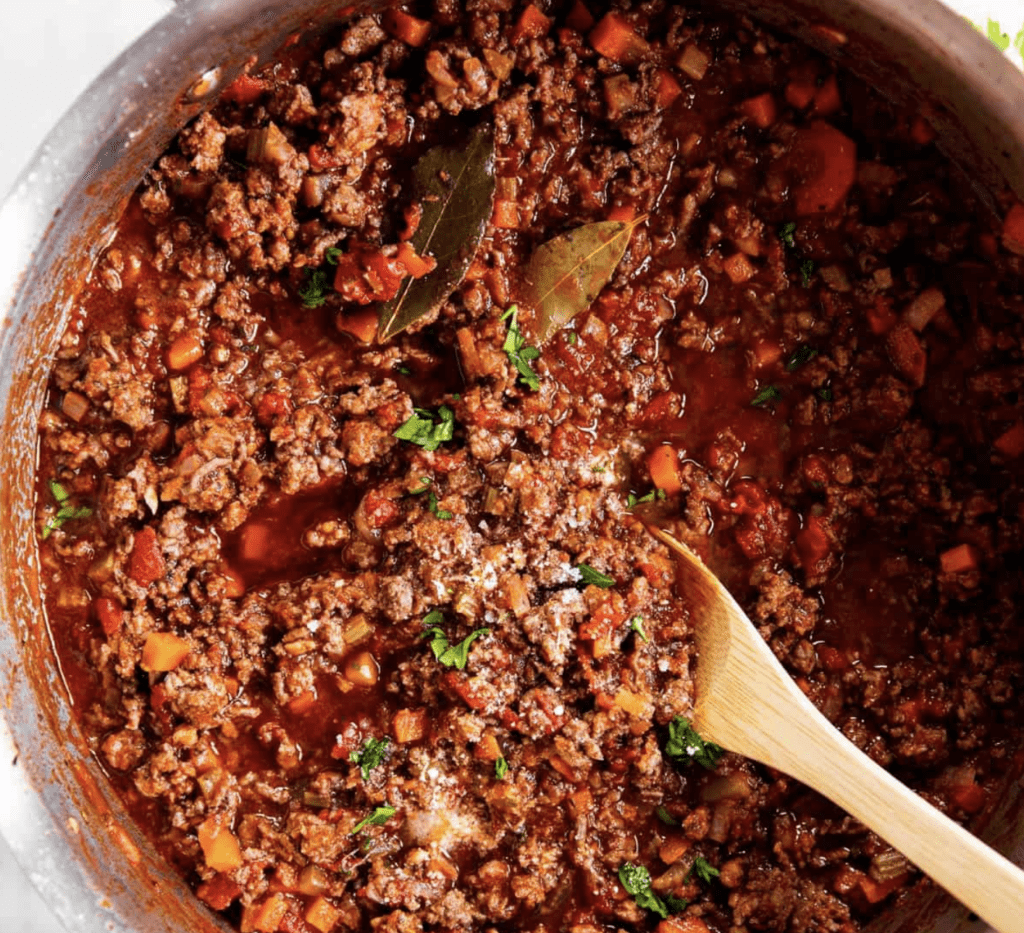
Best Pasta Sauces – Bolognese
Bolognese sauce is a meat-based sauce in Italian cuisine, typical of the city of Bologna.
To obtain the best Bolognese sauce it is preferable to use tomato puree (passata).
It is advised to never use canned peeled tomatoes and or fresh tomatoes because they release a lot of water during cooking and would therefore affect the intense flavor and its consistency.
In Italy, Bolognese is traditionally served fresh egg Tagliatelle.
Some like to serve pappardelle with the sauce.
And of course, always cooked to al dente.
The sauce is also used to make a very popular Lasagna alla Bolognese.
Bolognese Cooking Instructions
Cut the carrot, celery and onion very fine (must not too much that it becomes pulpy when cooked).
In a medium to large heavy pot add the olive oil and chopped vegetables, cook covered on low heat (stirring occasionally) until onion is transparent.
Increase the heat to medium and add the ground beef and pork.
Stirring as the meat is cooking to break up the pieces.
Once the meat has browned turned the heat up to high and add the wine.
Cook until the alcohol has evaporated (about 20-30 seconds) and the liquid has evaporated.
Decrease the heat to medium/low and add the tomato paste, puree, salt, pepper and bay leaf.
Gradually decrease the heat to the lowest setting cover and let simmer for three hours (the mixture should not boil).
Stir occasionally.
After the time has passed remove the bay leaf and add the milk, heat thoroughly for a couple of minutes.
Serve over cooked (al dente) pasta.
Bolognese Ingredients
1 small/medium carrot
1 small celery stalk
1 small onion
10 1/2 ounces ground beef (70-80%)
10 1/2 ounces ground pork
1/2 cup dry red wine
2 tablespoons tomato paste
2 1/4 cups tomato puree (passata)
2-3 pinches salt
2 dashes pepper
1-2 whole bay leaves
1/3 cup milk (2 % or whole milk)
Best Pasta Sauces – Ragu
Ragu is another traditional Italian sauce that, like bolognese, is also meat-based.
Ragus are traditionally thick on the larger pieces of meat and have just a small amount of tomato sauce added to them for flavor.
To cook a meat sauce (ragù), a mixture of cuts of beef and pork is generally used, opting for fatty meat that can withstand the long cooking times required for the preparation of this tasty sauce.
Usually 6 hours is required whereas 2-3 hours is needed for Bolognese.
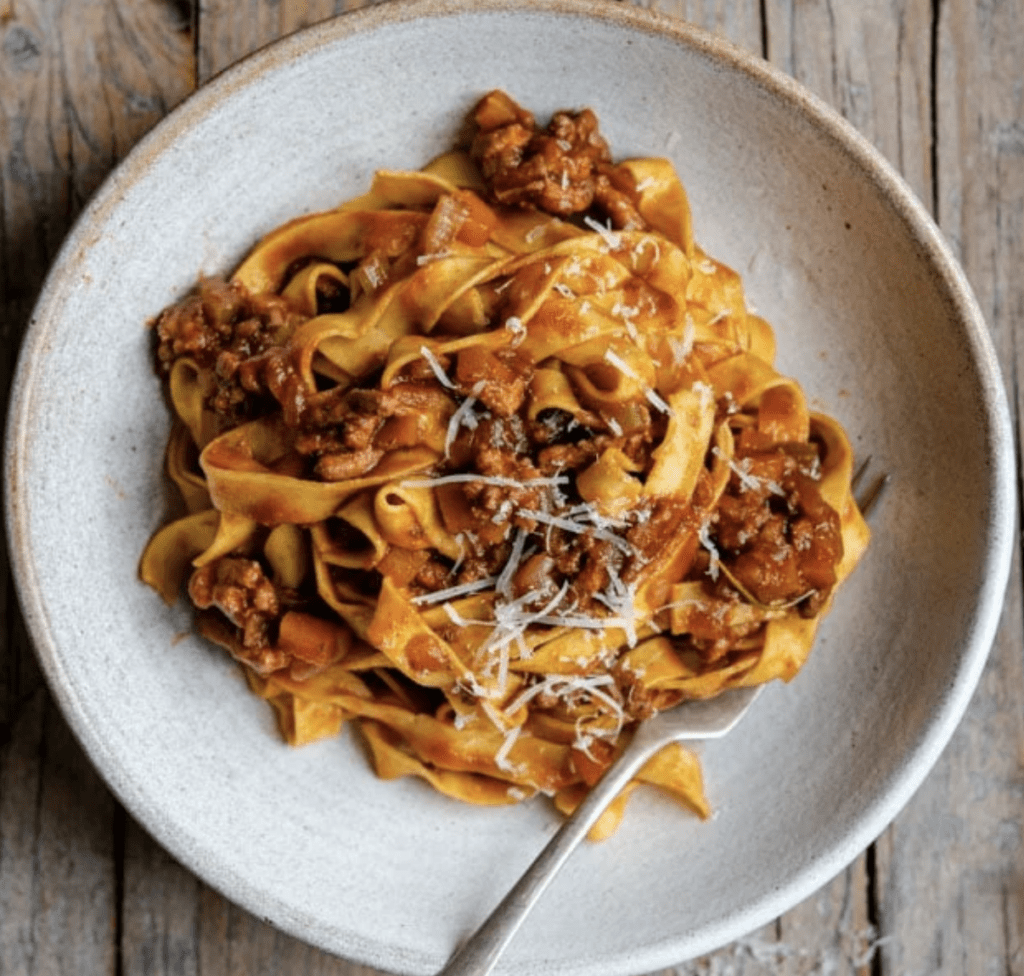
Best Pasta Sauces – Ragu
This Italian ragu is slow-cooked because it needs time to develop all the incredible flavors BUT it’s not as time-consuming as you may think.
This ragu needs a minimum of 2.5 hours cooking time so you can easily make it only a few hours before serving it.
That being said the longer it has to simmer the better the flavor will be, just remember that you’ll need to keep topping up with water or stock to stop it reducing too much.
The Difference Between Ragu & Bolognese
There are hundreds of different types of ragu all containing different meats or vegetables like our Venetian Duck Ragu (perfect for special occasions) and our Sausage Ragu which is super easy.
It’s also traditionally served with tagliatelle pasta and never spaghetti which is why you’ll hear Italians say that Spaghetti Bolognese doesn’t exist.
Slow Cooked Beef Ragu
This Italian ragu is slow-cooked because it needs time to develop all the incredible flavours BUT it’s not as time-consuming as you may think.
Because this classic beef ragu recipe is usually made with ground beef and pork it doesn’t need as much time as a big chunk of meat would to break down and tenderize.
This ragu needs a minimum of 2.5 hours cooking time so you can easily make it only a few hours before serving it.
That being said the longer it has to simmer the better the flavor will be, just remember that you’ll need to keep topping up with water or stock to stop it reducing too much.
Step By Step Cooking Instructions For Beef Ragu
The ragu starts like a lot of Italian sauces, stews and soups, with Il Soffritto.
Il Soffritto is very simply, finely chopped carrot, celery and white onion sauteed slowly with a little chilli pepper olive oil for about 10 minutes until soft but not browned.
This adds an incredible depth of flavor.
How to Make Il Soffritto
Finely chop equal amounts of carrot, white onion and celery
To make Italian beef ragu, I use 1 carrot, 1 celery stick and 1 white onion.
Saute the chopped veggies in a large pan with a little olive oil and chili pepper.
The key is to saute the veg slowly on a low/medium heat so they soften and release all the delicious flavors without browning or burning (around 7-8 minutes).
Once the vegetables are soft add the ground beef and pork (mince) to the pan and brown then add the red wine and continue to cook until the wine has reduced by half.
Once the wine has reduced add the tomato passata/pureed tomatoes and half of the beef stock.
Stir the sauce and let it simmer on a low heat for 2 and a half hours topping up the rest of the stock as it reduces.
Pro Tip: Remember to check on the ragu every now and then to stir it and add extra stock or water if needed.
How to Get the Best Flavor for Slow Cooked Beef Ragu
An important tip about making this classic recipe is to make sure you use equal amounts of beef and pork.
Beef is a lean meat whereas pork is much sweeter and fattier and adds a tonne of extra flavor to a ragu.
If you use 50% beef and pork instead of all beef you’ll notice a huge difference in flavor and that’s exactly how it’s made in Italy.
Best Pasta Sauces – Marinara Sauce
One of the most popular types of sauce for pasta is marinara pasta sauce.
However, this tomato-based sauce has its origins in Italian-American communities in the USA, rather than in Italy itself.
That doesn’t stop it from being delicious, and with a base of tomatoes, garlic, and Italian herbs and seasonings, it’s easy to make marinara pasta sauce from scratch.
Marinara works deliciously well with meatballs, but it’s also found a place in lasagnas, casseroles, and even sandwiches.
Marinara sauce, also known as a red sauce, features tomatoes as the base ingredient alongside complementary ingredients, such as oregano, garlic cloves, fresh basil leaves, olive oil, bay leaves, red pepper flakes, and tomato paste.
You can serve marinara sauce as a pasta sauce or add ground beef or meatballs to make spaghetti sauce.
Marinara also has high versatility and can work as a dipping sauce for breadsticks.
In Naples, the birthplace of pizza, marinara is also a style of pizza, topped simply with tomato purée, thinly sliced garlic cloves, a pinch of oregano, and a spiral of olive oil.
For an incredible pizza sauce, you can take a homemade marinara sauce recipe (using fresh tomatoes or canned tomatoes from the grocery store) and simmer on medium heat to reach your desired consistency.

Best Pasta Sauces – Marinara Sauce
Heat the olive oil in a large saucepan over medium heat.
Cook the onions for 3-4 minutes, then add the chopped garlic cloves.
Cook for another minute to sear the garlic.
Add the tomatoes (San Marzano) , Italian seasoning, basil, 1 teaspoon salt and a few grinds of fresh pepper.
You can use an immersion blender to puree the whole tomatoes.
Add the chopped basil and Italian parsley.
Bring to a simmer and cook, stirring occasionally, for 7 minutes.
Take off the heat and stir in the butter until melted.
Add salt and pepper to taste.
Bring to a light boil and reduce the heat to a simmer.
Continue cooking for 15 minutes.
Marinara Sauce Ingredients
1/3 cup olive oil
6 cloves garlic, minced
Three 26-ounce cartons chopped tomatoes
1 teaspoon Italian seasoning
1 large basil sprig
Kosher salt and freshly ground black pepper
3 tablespoons unsalted butter
Best Pasta Sauces – Penne Pomodoro (Tomato and Basil)
Beloved in Italy, Pomodoro sauce is known for its straightforward yet vibrant flavor.
The sauce is prepared with ripe tomatoes, fragrant garlic, premium olive oil, and a hint of basil, which infuse the sauce with brilliant hues and strong flavors.
Pomodoro sauce is a tomato-based pasta sauce made from fresh tomatoes, garlic, olive oil, and fresh basil.
In Italian, pomodoro means “golden apple,” because traditionally cooks made the sauce with tomatoes that were slightly yellow in color, resembling the local apples.
Pomodoro sauce has finely diced tomatoes or crushed tomatoes to give it a very thick and creamy texture.
Italian recipes may have variations on the ingredients in the pomodoro sauce, such as including different fresh herbs and spices like dried oregano.
Pasta pomodoro is a favorite pasta dish known for its smooth and creamy texture and commonly comes topped with parmesan cheese.
The ingredients combine after being perfectly slow-cooked to provide a rich and savory flavor that brings out the best in any pasta meal.
This Penne Pomodoro is a simple tomato pasta recipe made with an easy, flavor-packed tomato sauce and fresh basil leaves.
The Difference Between Pomodoro Sauce and Marinara sauce
The difference between Pomodoro sauce and Marinara sauce.
In general, Pomodoro sauce is usually thicker because chefs use crushed tomatoes as the base.
On the other hand, marinara usually includes oregano, red pepper flakes, garlic cloves, basil leaves, bay leaves, and tomatoes.
Marinara sauce is a tomato-based sauce that is more liquidy, while pomodoro sauce is a thicker sauce with crushed tomoatos.

Cooking Instructions for Penne Pomodoro (Tomato and Basil)
Put the oil, fresh & dried herbs and garlic in a skillet (frying pan) and saute the garlic until fragrant.
Add the pureed tomatoes and tomato pasta and stir to combine.
Gently simmer the sauce until the penne pasta is al dente, about 8 minutes.
Reserve 1 cup of pasta water, drain the rest and add the pasta to the sauce.
Toss or stir the pasta to coat in the sauce, add a little splash of reserved pasta water to help emulsify the sauce. When coated add in some fresh chopped basil and stir, serve.
Ingredients for Penne Pomodoro (Tomato and Basil)
Olive Oil – used to saute the herbs and garlic.
Garlic – must be fresh for this recipe, finely chopped.
Tomatoes – I use smooth passata aka sieved tomatoes or pureed tomatoes.
Tomato Paste – This adds richness and depth to the tomato flavor (again I use Cirio).
Fresh Herbs – fresh basil, parsley and dried oregano (just a small amount of each).
Tips for Making Penne Pomodoro
Make sure to salt the pasta water generously.
As soon as the water comes to a boil add the pasta and start cooking the sauce.
Make sure to reserve 1 cup of pasta water, you won’t need it all but a splash or two will help emulsify the sauce adding even more flavor.
Use high-quality tomatoes for this recipe.
Add a pinch of salt and pepper to the sauce before adding the pasta.
If you don’t have penne pasta then any pasta shape will do from rigatoni to spaghetti.
You can make the sauce in advance to make the meal even quicker when you’re ready to eat.
You can also make a double or triple or even more of the sauce and freeze it for later.
Variations for Making Penne Pomodoro
There are so many ways to adapt this recipe from adding veggies, meat or even bubbling cheese.
Here are some delicious ideas;
Add some pancetta in with the garlic and herbs.
Fresh red chilli would be so delicious and would add a nice spicy kick.
Switch the herbs for any fresh herbs you like.
Add the pasta to a baking dish and top with mozzarella or your favorite melting cheese and put it under the broiler (grill) until melted and bubbling.
Easy Classic Basil Pesto
Pesto is a fantastic healthy pasta sauce that’s traditionally prepared with a distinctive base of basil.
You mix in pine nuts, a little olive oil, and plenty of cheese (usually Parmigiano-Reggiano), alongside a few herbs and spices.
The basil gives pesto sauce that famous green color, and as it’s such a light sauce, pesto can simply be stirred into your pasta once cooked, rather than having to be simmered on the side.
Pesto is an easy spaghetti sauce that can be blended together when you have the correct ingredients, and it makes for a delicious tomato sauce substitute when you’re bored of the ragus and the marinara.
Alfredo is neither light nor tomato-based, as it’s prepared using a heavy base of thick cream, butter, and cheese.
This isn’t one for the calorie counters out there, but it is the best sauce for lovers of rich, wholesome flavors.
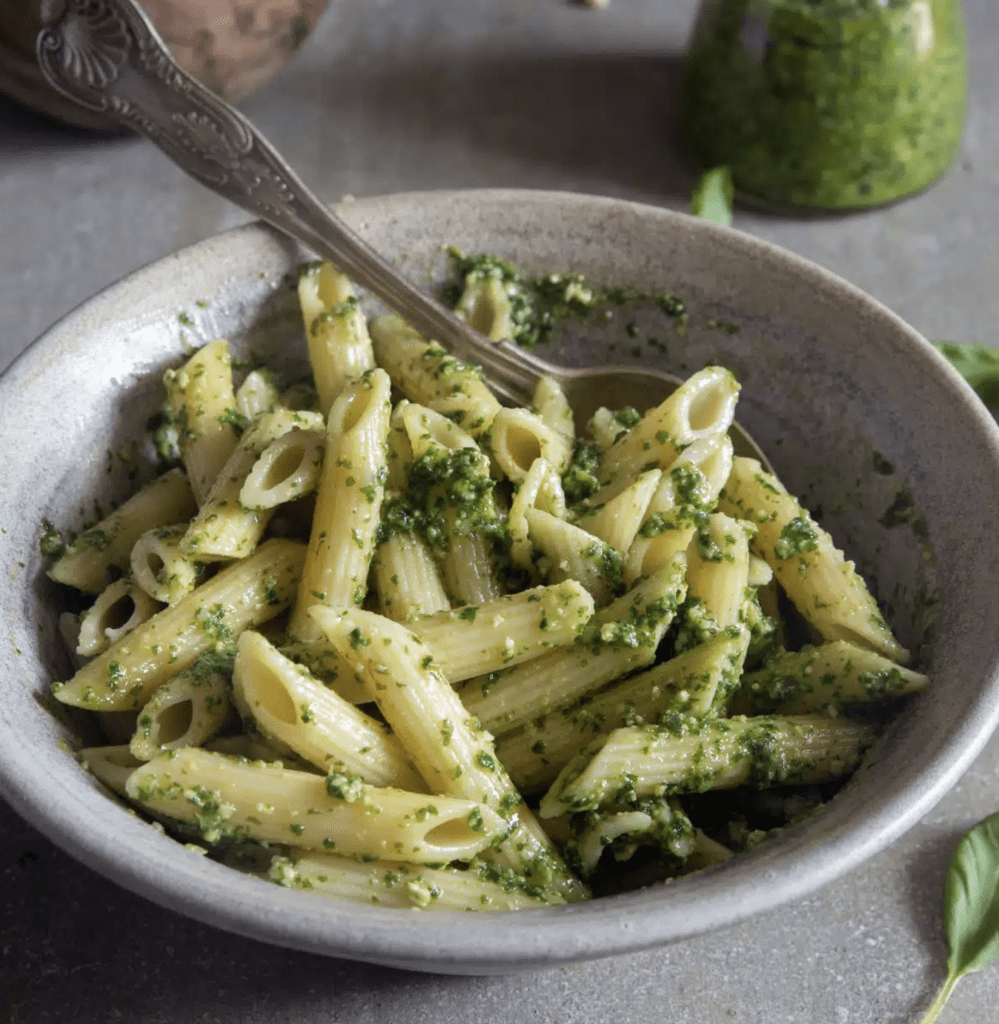
Easy Classic Basil Pesto
Pesto alla Genovese is a traditional condiment typical of Genova the capital of Liguria in Italy.
Its main ingredient is basil, although now a lot of different ingredients are used to make a Pesto.
Originally made using a marble mortar and a circular motion with a wooden pestle, now a food processor makes it fast and easy.
All the ingredients including the basil, salt, pine nuts and garlic, Parmesan (and/or Pecorino), and of course extra virgin olive oil were placed in the mortar and combined until a thick creamy paste was made.
Pesto is never cooked and is usually tossed with pasta.
Basil Pesto, is easy and can be made in five minutes with a few ingredients.
Basil pesto is delicious and so versatile, it can be used in a variety of dishes.
Classic Basil Pesto Cooking Instructions
Place the food processor container and blade in the refrigerator for at least one hour.
Meanwhile wash and dry fresh basil leaves.
Remove the container and blade from the refrigerator.
Add ⅓ basil leaves, half the salt, ⅓ of the olive oil and pulse to combine.
Add another ⅓ of the basil leaves and pulse to combine add the remaining basil leaves and pulse.
Add the pine nuts, Parmesan Cheese and Pecorino, another ⅓ olive oil, remaining salt and pulse to combine, add remaining olive oil and garlic, pulse on high to combine.
Serve over cooked pasta.
Makes approximately 1 cup pesto, I served half over 3 cups cooked Penne Pasta with a little olive oil drizzled and tossed.
Left over Pesto should be refrigerated.
Classic Basil Pesto Ingredients
1¾ ounces fresh basil (about 4 cups) (50 grams)
5 tablespoons freshly grated Parmesan Cheese (32 grams)
2 tablespoons Pecorino Cheese (13 grams)
⅓ cup olive oil (72 grams)
1 tablespoon pine nuts (heaping soup spoon)
2 cloves garlic chopped
¼ teaspoon salt
Best Pasta Sauces – Authentic Fettuccine Alfredo
Alfredo is best served with thick, long pasta noodles, with fettuccine being the most popular.
The sauce is often combined with white meat or seafood, particularly chicken or shrimp.
Alfredo goes down particularly well with a glass of white wine on the weekend.
And for those who are looking for a non-alcohol drink to go with your pasta, there definitely are options! Iced teas, especially herbal ones, blend beautifully with rich flavors.
If you want something more similar to wine, you can’t go wrong with pomegranate juice.
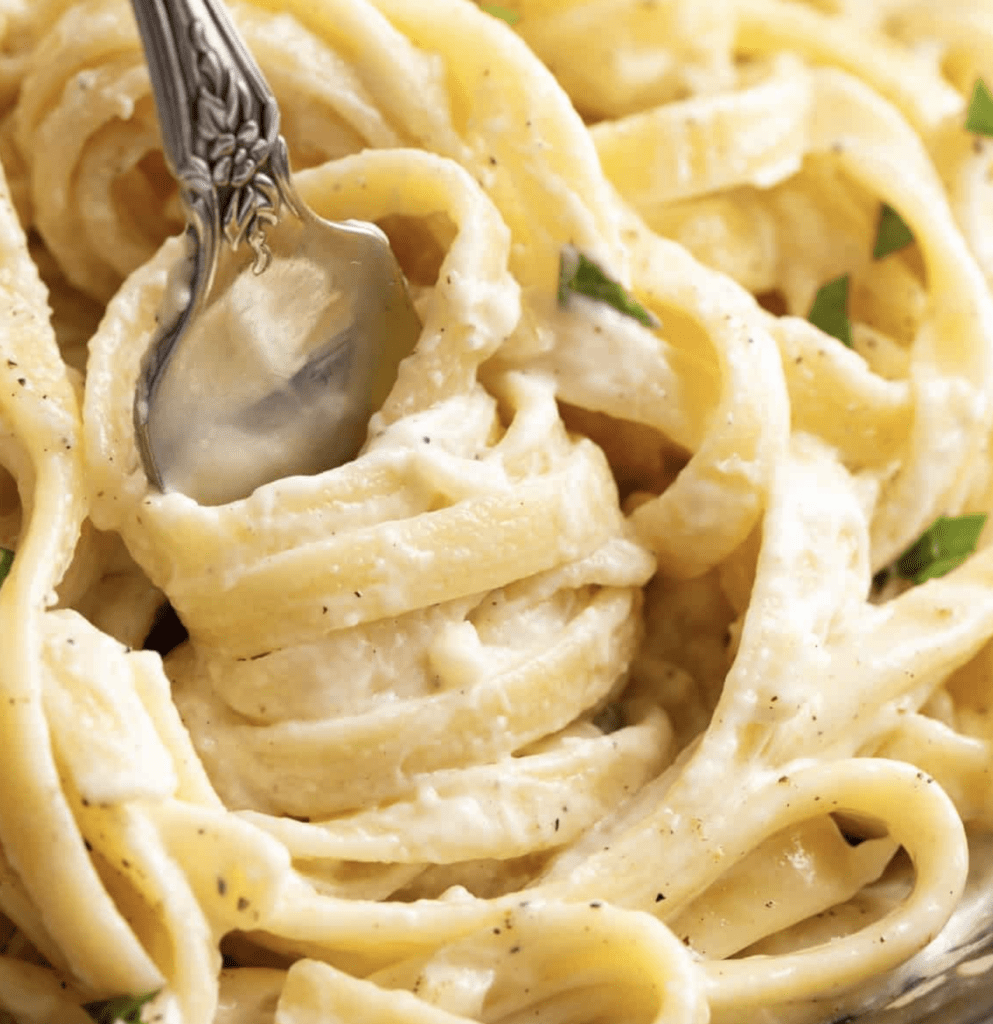
Best Pasta Sauces – Authentic Fettuccine Alfredo
Fettuccine Alfredo is a dish that Americans think of in their list of “classic Italian dishes” right along with Spaghetti and Meatballs and Ravioli.
But, the dish that is known to Americans is not quite the authentic Italian version.
Fettuccine Alfredo started off as the desperate attempt of Roman restaurant owner, Alfredo di Lelio, to find something that his pregnant wife, who had lost most of her appetite due to pregnancy, would be able to eat.
So, he added some Parmesan cheese to an everyday Italian dish, fettuccine al burro (Fettuccine with Butter).
Best Pasta Sauces – Authentic Fettuccine Alfredo Cooking Instructions
While the pasta heats, gently melt the butter over medium heat in a large, non-stick skillet with high sides.
Drain the pasta (reserving the water) and transfer the pasta to the skillet with the melted butter.
Add a 1/2 tsp salt and toss the pasta with a tongs to combine (nonstick, silicone tongs work best).
Reduce the heat to medium low.
Add a handful of grated cheese and a ladle of hot pasta water, tossing the pasta continuously with your tongs to incorporate the cheese.
Add more cheese, a little at a time, tossing between each addition, until all the cheese has been used.
Add more hot pasta water as needed to melt the cheese so that it coats the noodles.
Taste the pasta and adjust the salt as necessary.
Serve immediately.
Best Pasta Sauces – Authentic Fettuccine Alfredo Cooking Ingredients
1 lb fettuccine noodles, dry
12 Tbsp unsalted butter
6 oz Parmigiano-Reggiano cheese, freshly grated
1/2 – 1 tsp salt, (to taste)
Best Pasta Sauces – Carbonara Sauce
Carbonara sauce is a classic staple of Italian cuisine, and it’s one of the best pasta sauce alternatives you can learn to cook if you need a break from tomato-based sauces.
Like Alfredo sauce, carbonara is also cream-based and contains a decadently large quantity of grated cheese.
The main difference, however, is the addition of egg to the recipe, which allows the sauce to cling to the pasta as you cook it together.
Carbonara, in its most basic form, often only involves egg and cheese and a little cream, while the US version usually goes all out to make a super-thick, rich sauce.
Carbonara is cooked together with long thick pasta noodles, and the most common addition to the dish is bacon or pork.
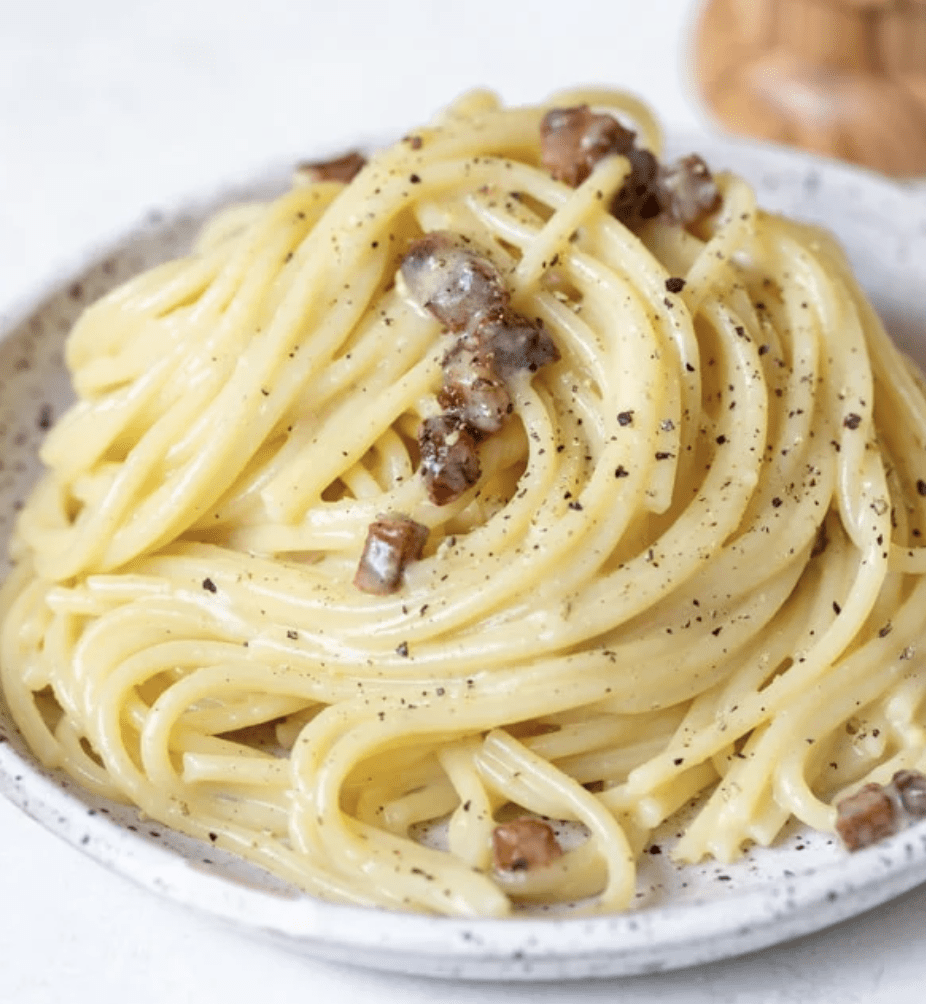
Authentic Spaghetti Carbonara
This Authentic Spaghetti Carbonara is made with just 4 ingredients, egg yolks, black pepper, pecorino and guanciale and of course Spaghetti.
Made in 15 minutes, this creamy authentic pasta recipe will make you think you are in Rome.
Egg yolks are what make this dish creamy, adding cream is a big no no in this dish but a little grease from the Guanciale is a must.
Whisking the yolks with some pecorino and adding hot pasta water is all you need to make this a creamy Italian pasta dish.
Guanciale is an Italian cured meat from the pork jowl (cheek).
The name is derived from the Italian word Guancia which means cheek in English.
Pancetta on the other hand is the pork belly that has been cured.
Guanciale like pancetta has a high fat to meat ratio, which mean it has a tender texture with a sweet pork flavor.
Although Guanciale definitely has a richer flavor and a softer texture.
Carbonara Cooking Instructions
In a small/medium bowl beat until well combined the egg yolks, add the grated pecorino and pepper, beat to combine.
Just before adding to the pan add 1/3 – 1/2 cup (80-120ml) of hot pasta water and mix to combine well.
Slice the Guanciale into short thin strips.
In a large pan add the olive oil and Guanciale, cook on medium heat until desired doneness.
Remove the Guanciale to a clean plate.
Do not remove the oil (& fat) from the pan.
On medium/high heat, add the al dente pasta to the pan, and a 1/3-1/2 cup (80-120 ml) of hot pasta water and stir to combine.
Remove the pan from the heat and add the egg mixture and quickly combine, add 1/3 -1/2 cup of hot pasta water and toss continually until well combined and creamy.
Add the Guanciale and gently mix.
Serve immediately topped with freshly grated pecorino and black pepper.
Carbonara Ingredients
3 cups cooked spaghetti (about 6 ounces dry) (600 grams cooked or 300 grams dry)
4 large egg yolks
1 cup pecorino freshly grated (100 grams)
½-1 teaspoon black pepper (freshly ground if possible)
2 tablespoons olive oil
½-¾ cup guanciale (100-150 grams)
2-3 tablespoons pecorino freshly grated
Best Pasta Sauces – Cacio e Pepe
Cacio e pepe is a fantastically easy, yet remarkably delicious pasta sauce that you can easily prepare at home.
Cacio e pepe is simply cheese and black pepper, two ingredients that you likely already have in your kitchen.
Cheese and pepper are mixed together, then added to long spaghetti noodles that are fresh out of the pan.
The cheese melts into the spaghetti to produce a delightful sauce that takes no time at all to cook.
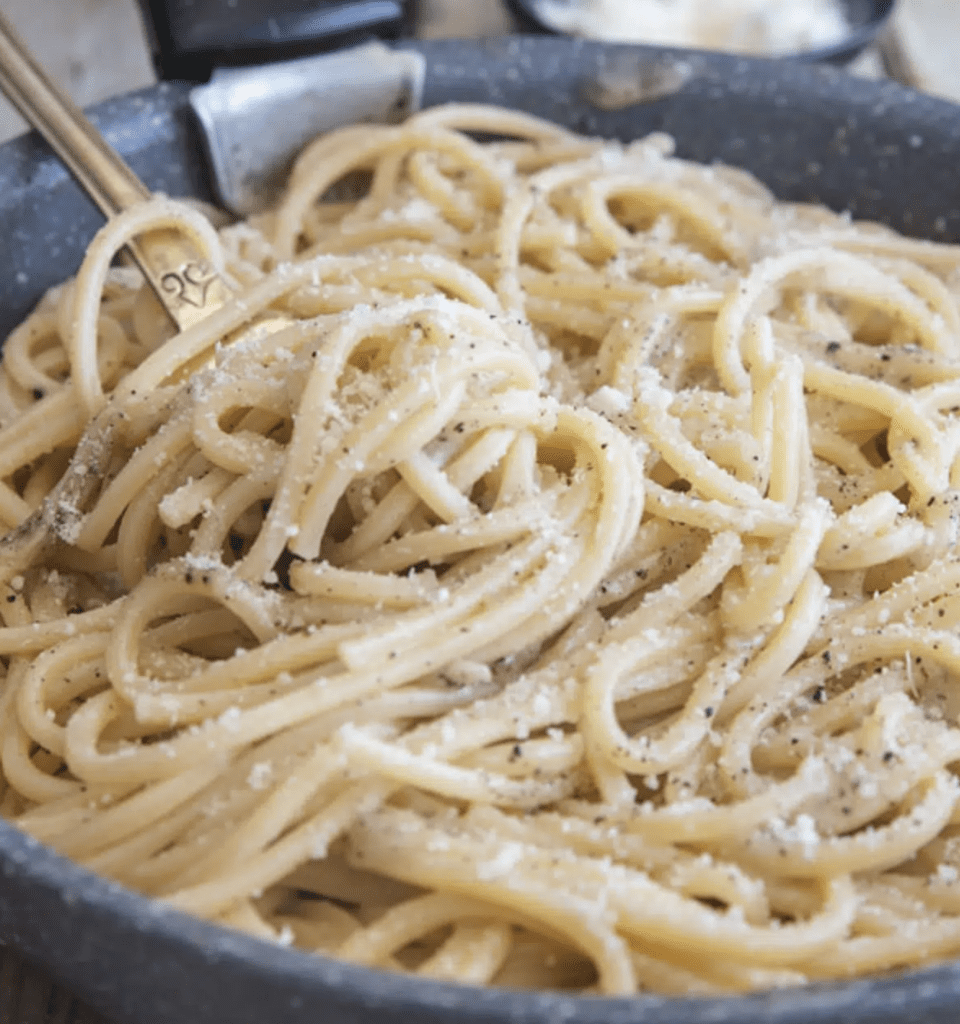
Cacio e Pepe
But Cacio e Pepe which means “cheese and pepper” in Italian, it is considered one of the best if not the best by a lot of people, including Anthony Bourdain.
In an authentic recipe there is no salted or unsalted butter or olive oil, and of course just certain types of grated cheese.
Cacio e Pepe Cooking Instructions
Boil the water in a large pot, add the salt and the spaghetti.
In a small bowl add the pecorino (and a little parmesan) and combine, add ⅓-½ cup (or a little more if needed) of hot pasta water and stir to make a creamy sauce.
Cook the pasta about two minutes less than the package directions.
While pasta is cooking, ground the pepper corns until you have the desired amount of pepper.
About 3 minutes before the time is up (2 minutes less then directed) in a large skillet pan add the freshly ground pepper and heat on high for about 30 seconds or until you can smell the pepper, then add about ⅓-½ cup of hot pasta water (you need the starchy pasta water which helps prevent clumping).
In a small bowl add the pecorino and a little parmesan, combine, add half a cup (or a little more if needed) of hot pasta water and stir to make a creamy sauce.
Add the spaghetti and the pecorino cream sauce, quickly toss and stir gently to combine.
Add a little pasta water if needed and continue to combine.
When the spaghetti is cooked (about a minute) and the creamy sauce has thickened slightly, the Cacio e Pepe is ready.
Top with a sprinkle of black pepper and pecorino cheese.
Cacio e Pepe Cooking Instructions
3 cups cooked spaghetti
3/4-1 tablespoon freshly ground black pepper
1 1/4 cups freshly grated pecorino cheese
1/4 cup freshly grated parmesan cheese*
Why add Pasta Water?
Adding pasta water is done for a few reasons.
One, it makes the pasta and the sauce mix well.
Two, the starch contained in the cooking water creates a delicious cream that combines the pasta and sauce together which will give the dish a pleasant taste.
Pecorino or Parmigiana?
Good question, if you ask most Italians they will say Pecorino and only Pecorino.
Although it is actually recommended to use 3/4 Pecorino and 1/4 Parmigiana.
Make sure you use a good quality Pecorino Romano cheese (it should be very soft, light and flakey).
Since there are only a few ingredients you will want the best.
Best Pasta Sauces – Arrabbiata Sauce
One Italian pasta sauce that is bursting with flavor and has a kick of heat is Arrabbiata Sauce.
Its fiery flavor will awaken your taste buds because it is made with garlic, red chili peppers, and olive oil.
Arrabiata sauce is frequently served with penne pasta or other short tube-shaped noodles.
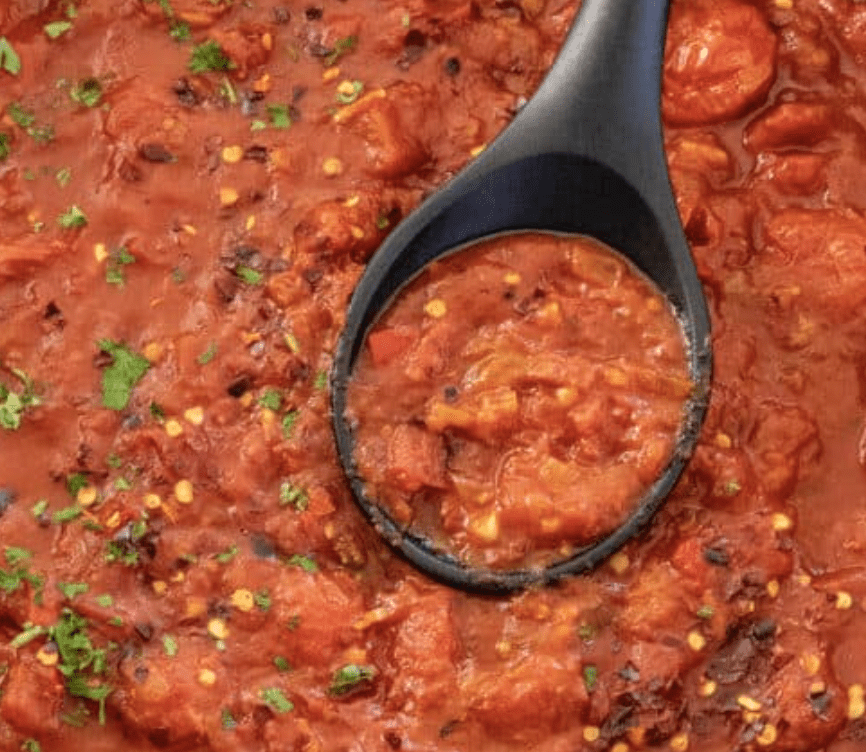
Arrabbiata Sauce
Penne all’ Arrabbiata is a super simple Italian pasta recipe made with penne pasta in a beautiful spicy tomato sauce that’s super quick and easy to make.
If you’re looking for an easy dish with a spicy kick then this is for you!
Arrabbiata Sauce Cooking Instructions
Meanwhile, heat the olive oil in a large skillet or non-stick pan and saute the garlic and chilli until fragrant (around 1 minute).
Add the tomatoes and stir to combine.
Rinse the tomato can out with ¼ cup (60ml) of water and add it to the sauce with a good pinch of salt and pepper.
Use a potato masher to crush the tomatoes in the pan (you can also crush them with your hands before adding).
Simmer the sauce on a medium heat for 8-10 minutes or until the pasta is ready.
Reserve ¼ cup of pasta water then drain the pasta and add to the sauce.
Toss the pasta in the sauce and add reserved pasta water as needed, serve with fresh parsley or a little parmesan.
Arrabbiata Sauce Pro Tips
Use the highest quality tomatoes you can find for the best results.
You can use fresh or dried chilli for this recipe and add as little or as much as you like just remember you can always add but can’t take it away so always taste as you go.
Although you can switch between fresh and dried chilli do not use garlic powder instead of fresh garlic as you won’t get the same delicious flavor.
This sauce will keep well in the fridge for up to 5 days or can be frozen in suitable containers.
Thaw completely as needed, reheat and toss with pasta.
Arrabbiata Sauce Ingredients
14 oz penne pasta (4 cups/400g)
14 oz canned whole peeled plum tomatoes San Marzano or high quality (400g)
2 garlic cloves finely sliced
1 whole red chilli seeds removed and finely sliced or sub ½-1 teaspoon red pepper flakes
1 tablespoon olive oil
Salt and pepper to season
Best Pasta Sauces – Puttanesca Sauce
Puttanesca sauce is a hearty Italian pasta sauce made from strong, salty, and spicy ingredients.
The sauce has a distinctive saline, somewhat acidic flavor that comes from the combination of tomatoes, garlic, olives, capers, and red pepper flakes.
Any pasta meal can benefit from the energy and assertiveness that puttanesca sauce brings.
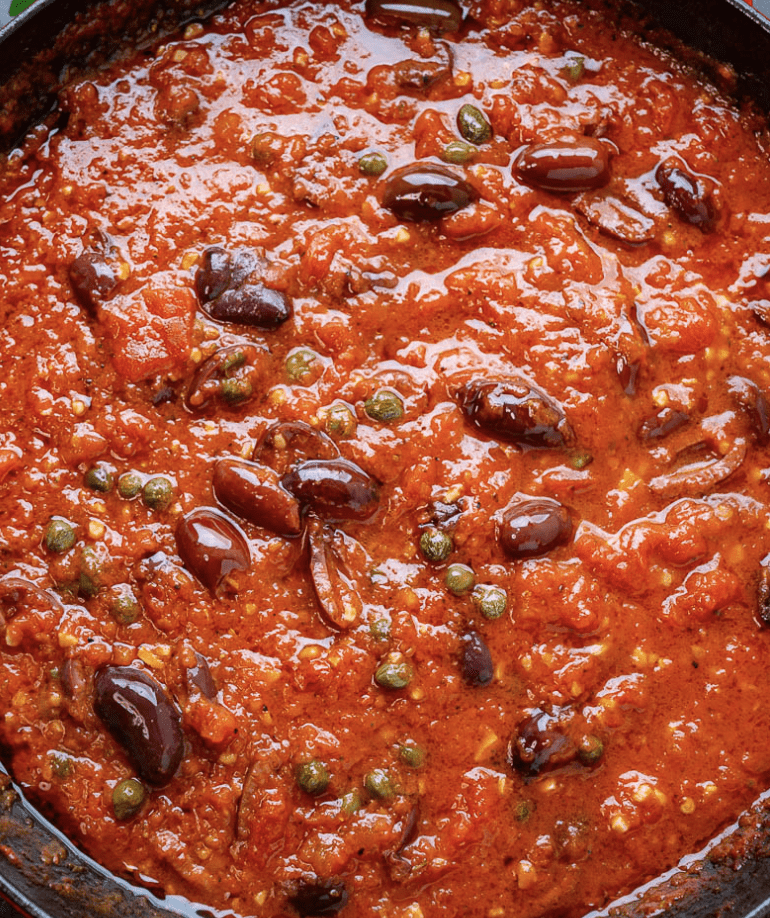
Puttanesca Sauce
Sugo alla puttanesca (puttanesca sauce) is a flavorful classic Southern Italian tomato sauce dating back to the 20th century.
There are many theories on the origins of pasta puttanesca, but the most popular one ties it in with the meaning behind ‘puttana’ which translates roughly to mean prostitute.
Some say that the sauce with its bold aroma was thought to lure potential clients and still others say it was a hearty meal to partake between clients.
Regardless, today simple ingredients in pasta puttanesca are what entices us to this recipe.
Made with pantry staples such as canned tomatoes, capers, olives, fresh garlic and pepper flakes its complex rich taste pairs perfectly with spaghetti pasta for an easy dinner any night of the week.
To start, prep your pasta puttanesca ingredients.
Chop the parsley, if using a fresh hot pepper then finely chop, rinse and drain the capers, cut the pelati tomatoes into small pieces and cut the olives in half.
In a large pot, cook the pasta al dente in boiling salted water.
Drain the spaghetti and reserve some pasta water to add to the sauce.
While the water is boiling and pasta is cooking, in a large skillet or pan over medium heat, add the oil, garlic cloves and crushed red pepper flakes and cook for 1-2 minutes.
Puttanesca Sauce Ingredients
Olive Oil: A good quality extra virgin olive oil that you like is ideal.
Garlic: You will need 2-3 whole garlic cloves which will be flattened slightly to release their garlicky goodness.
Red Pepper Flakes: Hot pepper flakes or a fresh hot pepper chopped add just the right amount of spicy heat to pasta puttanesca.
Black Pepper – is can also be added either in place of hot pepper flakes or a combination.
Capers: These add a tangy flavor to the sauce.
Pelati Tomatoes: One 14 oz can of peeled San Marzano tomatoes is best, as they are known for their quality, sweetness and low acidity.
Fresh Parsley: Also known as Italian or flat leaf parsley, it adds bright fresh and herby flavor to this easy pasta puttanesca.
Kalamata Olives: Olives that are pitted and cut in half add the best briny flavor to the puttanesca sauce.
Authentic Italian recipes call for unpitted Gaeta olives, which you cut and pit yourself.
Best Pasta Sauces – Vodka Sauce
Vodka, a delightfully creamy sauce, is frequently used in Italian-American cooking.
The sauce has a distinctive and upscale flavor because it is created with tomatoes, heavy cream, and a dash of vodka.
Vodka is added to the sauce to bring out the aromas of the tomatoes and give it a smooth, creamy texture.
Given its opulent appearance and flavorful texture my rigatoni all vodka is the perfect meal to make
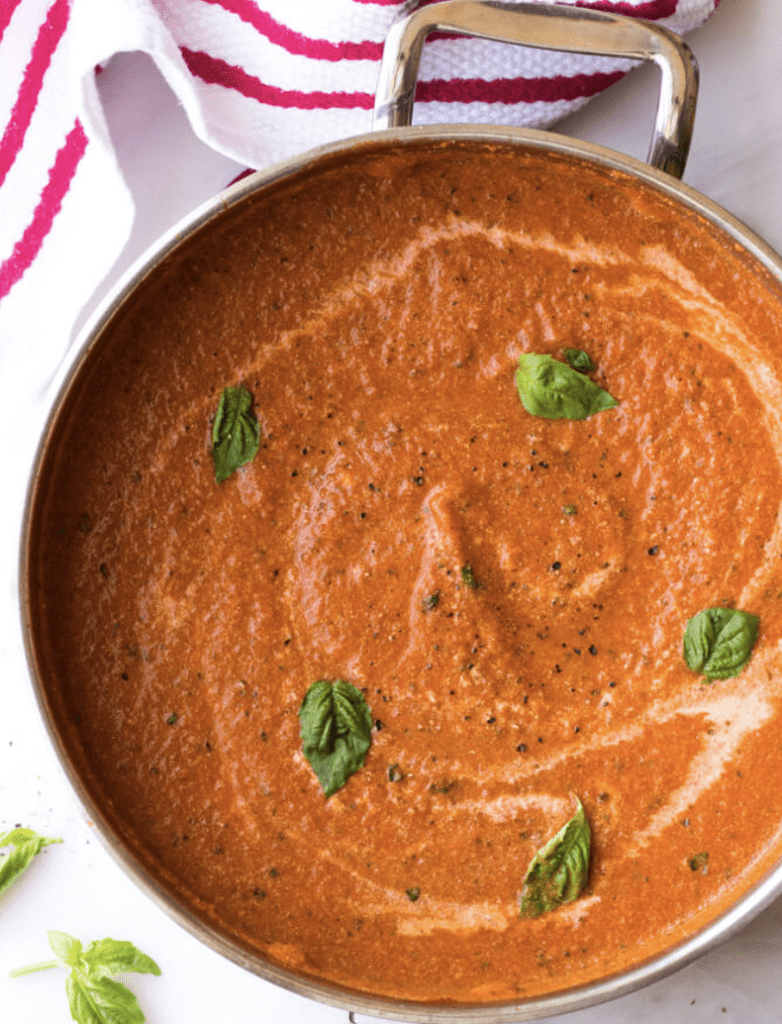
Vodka Sauce
Vodka Sauce a sauce is basically a simple tomato sauce (pomodoro sauce) that is pumped up with cream and vodka.
If you look through the jarred pasta sauces on any grocery-store shelf, you’re bound to come across a jar of pink/orange-hued vodka sauce.
This creamy sauce boasts a flavor and texture that fall somewhere between jarred Alfredo sauce and classic tomato sauce.
Vodka Sauce Cooking Instructions
In a large pot, cook penne according to its package instructions.
Drain and set aside when done.
Heat the oil in a deep sauté pan.
Add the pancetta (or bacon) and sauté for 2 minutes.
Add the minced garlic.
Sauté for 1 minutes.
Add the vodka and stir well, letting it simmer for 1 minute.
Add the crushed tomatoes, salt, and pepper.
Bring the mixture to a light simmer and simmer over medium low heat, uncovered, for 5-7 minutes, to thicken the sauce slightly.
Add the cream and heat the sauce just until it begins to simmer.
Remove the sauce from the heat.
Pour the sauce over the cooked and drained pasta.
Top with fresh parsley and basil just before serving.
Vodka Sauce Ingredients
¾ lb pasta, dry
1 Tbsp extra virgin olive oil
2 oz pancetta or bacon, cut into small pieces
4 garlic cloves, minced
½ c vodka
28 oz can crushed tomatoes
¾ tsp salt
¼ tsp pepper
½ c heavy cream
1 Tbsp fresh basil, chopped (or 1 tsp dry)
1 Tbsp fresh parsley, chopped (or 1 tsp dry)
The History of Penne alla Vodka
Vodka sauce is not a traditional Italian sauce, rather it is thought to have been introduced in Italy in the 1970s.
But, although we know its history to be recent, the actual origins of penne alla vodka are widely disputed, with many chefs claiming to be the inventors.
Some historians claim it was invented at a restaurant in Bologna, Italy, called Dante.
Others credit Luigi Franzese, a New York City chef, with the invention of a dish called Penne alla Russa, named for for the Russian influence the vodka brings to the sauce.
Still others say it was invented by a chef in Rome at the request of a vodka company who wanted to make their liquor more appealing to Italians.
Either way, penne alla vodka quickly grew in popularity in the 1970s and 80s.
Boutique & Luxury Hotels In Italy >>



